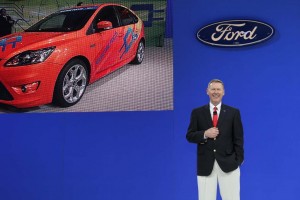Ford Motor Co. will team up with software giant Microsoft in an effort to make it “easier and more affordable” to purchase an electric vehicle, the automaker’s CEO Alan Mulally announced during an appearance at the New York Auto Show.
The big buzzword in the auto industry, these days, is “electrification,” with Ford and most of its rivals unleashing a wave of hybrids, plug-ins and battery-electric vehicles. But the transformation is likely to be a difficult and costly one, Mulally cautioned, during the 2010 auto show’s keynote speech and again during a Ford news conference.
The cost of battery technology is part of the problem, along with limited range. But there’s also the challenge of simply plugging in – and making sure there’s a ready and affordable supply of energy. That’s where Washington-based Microsoft comes in. The software giant plans to adapt its HOHM application to work on future Ford products, starting with the 2012 Focus Electric, a battery-powered version of the maker’s new compact passenger car.
In current form, HOHM is designed to help users find ways to control and reduce energy consumption, among other things by switching on appliances during off-peak hours, when many utilities charge less per kilowatt hour. That could prove particularly useful, Mulally noted, considering that an electric vehicle is likely to “double the electric consumption of the typical household.”
“The demand placed on the electric grid could be enormous” if the use of battery-powered vehicles becomes widespread,” said Microsoft CEO Steve Ballmer, who joined Ford’s Mulally via a video conference link.
One of the things the Ford version of HOHM will do is help a buyer determine if their home can handle the power demand of a battery car. If it can, the software will then allow an EV owner to “smart charge.”
If everyone with an electric vehicle were to come home and plug in, there would be “a proverbial traffic jam on the grid,” said Microsoft executive Troy Batterberg. Instead, HOHM will only begin charging a vehicle’s batteries when demand drops and utility rates are at their lowest.
In such situations, experts predict the cost of energy should come in at one to two cents a mile compared with 10 cents or more for a comparable vehicle powered by gasoline.
The Ford/Microsoft partnership is also aimed at helping utilities get a better feel for what the market needs in terms to support battery-powered vehicles. Setting up a compatible infrastructure, said Mulally, will be critical for the future of clean, green mobility.
This is the second partnership formed by Ford and Microsoft. The software giant developed the underlying technology powering Ford’s Sync, a voice-activated infotainment system.

